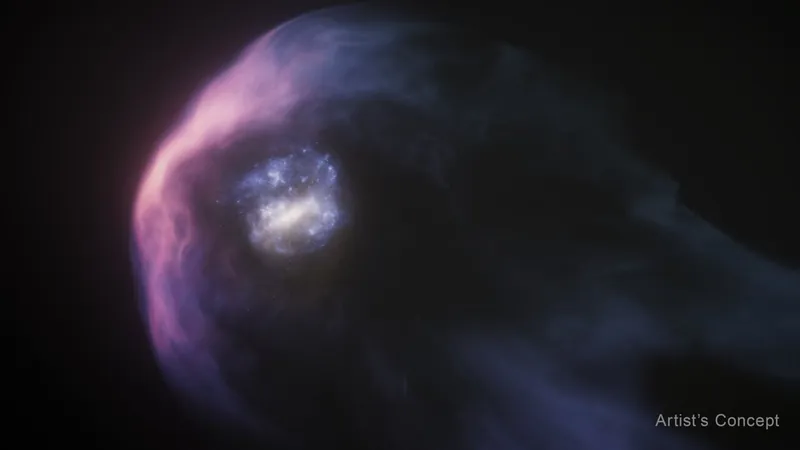
Milky Way's Gravitational Gusto: How a Dwarf Galaxy Was Stripped Bare!
2024-11-17
Author: Ming
The cosmic dance between galaxies takes an unexpected turn! The Hubble Space Telescope has unveiled stunning revelations about the Large Magellanic Cloud (LMC), a neighboring dwarf galaxy of our Milky Way. Recent observations show that the LMC has been caught in the Milky Way's gravitational grip, resulting in a dramatic loss of gas and dust from its halo.
New research indicates that as the LMC passed through the Milky Way's gaseous halo, it suffered significant stripping, leaving its own halo dramatically shrunken—about ten times smaller than those surrounding other galaxies of similar mass. Remarkably, despite this rough cosmic encounter, the LMC has managed to cling to enough gas and dust to continue birthing new stars. If it were any smaller, it might not have fared so well; further diminishment could have rendered it incapable of star formation and accelerated its decline into cosmic oblivion.
Originally thought to be a satellite galaxy of the Milky Way, scientists now believe the LMC is merely passing through our galaxy's domain. This close encounter has been characterized as the LMC's nearest approach to the Milky Way, leading to the stripping of a majority of the gas within its spherical halo. This significant loss of material has sparked intrigue and surprise among astronomers, particularly as they discovered that the halo measures only around 50,000 light-years in diameter.
The Dwarf Galaxy's Resilience
Despite suffering from this galactic brush, the LMC has demonstrated incredible resilience by retaining a compact halo rich in gas, a feat unlikely if it had a smaller mass. Comprising roughly 10% of the Milky Way's mass, the LMC's halo gas is currently being "quenched" by the Milky Way's own gaseous halo. A fascinating aspect of this interaction is the trailing wake of stripped gas and dust the LMC leaves behind—akin to a comet’s tail—illustrating the gravitational tumult of cosmic encounters.
Additionally, these findings shed light on a broader astrophysical concept known as "ram pressure stripping," commonly observed in Jellyfish galaxies that navigate the dense central regions of galaxy clusters. The implications of this research extend beyond just the LMC, highlighting the dynamic and often chaotic processes that shape galaxy evolution.
As we continue to explore the mysteries of our universe, the LMC’s story serves as a compelling reminder that even in the vastness of space, survival hinges on the delicate balance between cosmic forces. What's next for the LMC? Will it thrive, or will the Milky Way’s grasp become too suffocating? Stay tuned as astronomers delve deeper into this intergalactic saga!



 Brasil (PT)
Brasil (PT)
 Canada (EN)
Canada (EN)
 Chile (ES)
Chile (ES)
 España (ES)
España (ES)
 France (FR)
France (FR)
 Hong Kong (EN)
Hong Kong (EN)
 Italia (IT)
Italia (IT)
 日本 (JA)
日本 (JA)
 Magyarország (HU)
Magyarország (HU)
 Norge (NO)
Norge (NO)
 Polska (PL)
Polska (PL)
 Schweiz (DE)
Schweiz (DE)
 Singapore (EN)
Singapore (EN)
 Sverige (SV)
Sverige (SV)
 Suomi (FI)
Suomi (FI)
 Türkiye (TR)
Türkiye (TR)